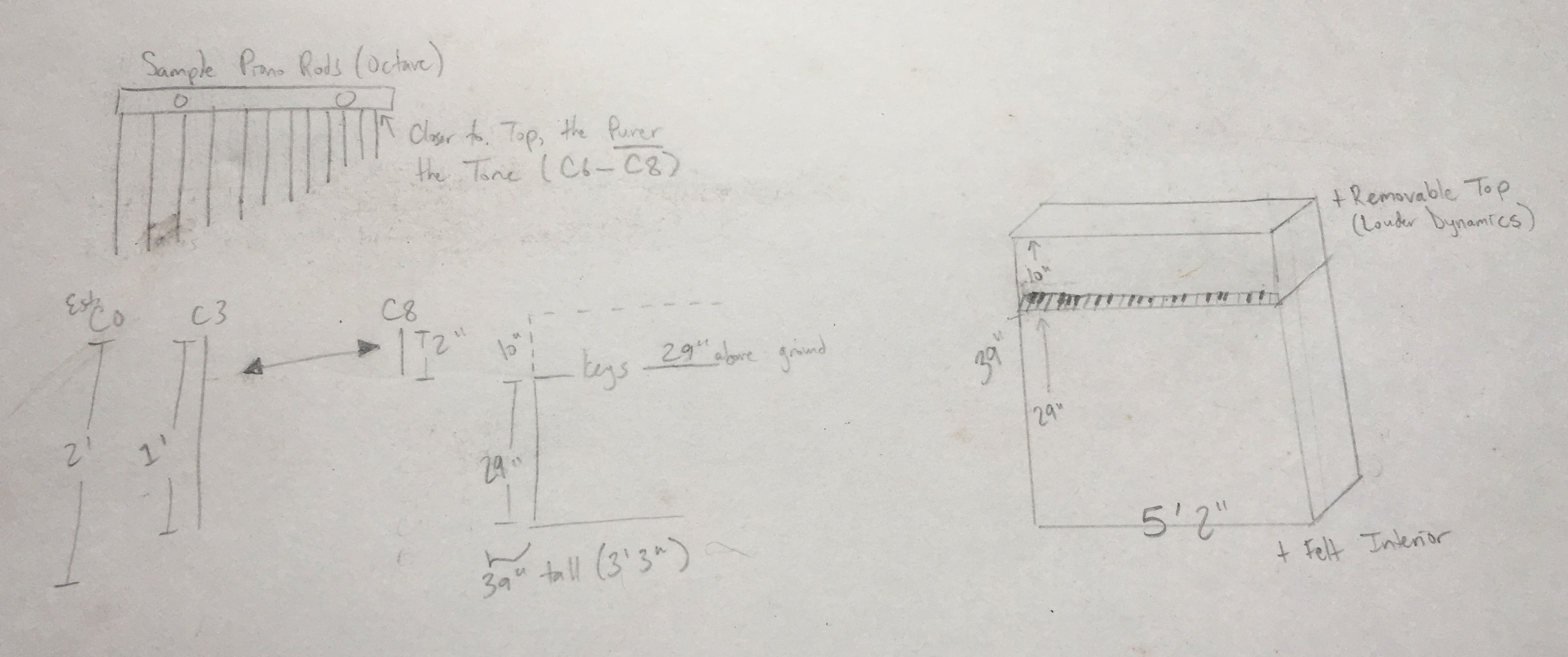The Expanded Toy Piano: Additional Insights
- Composing for Expanded Toy Piano
- Bowed Sounds
- Tine Stability
- Original Sketches
Depending on the setup and specific instruments involved, a composer should be aware of limitations. Connor's Watching the Sea realistically requires at least 2 people to perform. In a feature segment on Phyllis Chen, produced by CGTN America and viewable here (2016), two toy pianos can be seen stacked together; this encouraged the focus on having players double on multiple toy pianos. In the case of Connor's instruments, some pitches are available on multiple instruments, e.g. C4 is playable on the Tenor and Alto Toy Pianos, and the slight contrast in timbre may be preferable on a specific instrument.
The tines of a toy piano can be activated with bows if removed from their instrument bodies, or with fishing line if the tines are left inside the instrument bodies. Connor observed being able to produce complex multiphonics, closer in nature to those produced by woodwind instruments or on standard piano strings, when bowing the extended tines of his Bass Toy Piano. Multiple different individual pitches were producible from bowing at different points along the lengthened tines. For the unmodified tines of the Tenor and Alto Toy Pianos, and also on the shortened tines of the Soprano Toy Piano, it was possible to consistently produce a singular pitch, an overtone/harmonic a perfect 12th higher (i.e. C4 → G5). This overtone appeared to dissipate on the Soprano Toy Piano at the B6 key, i.e. an overtone of F#8.
(This is not unlike a standard piano, where fewer harmonics become available on higher strings, and those that are playable become softer; from E4–C#5, only two reliable harmonics are producible: the octave, and the perfect 12th, as written on this webpage from the PianoHarmonics.com website.)
The Piccolo Toy Piano demonstrated two different patterns. The first was produced by bowing the end of the tine, where a pitch matching the tine but 3 octaves lower sounded (C8 → C5). These tines also speak lower when struck with a hammer, but a much higher sound speaks when the tines are plucked. Bowing closer to the steel bar created sounds that were essentially equivalent in pitch to the fundamental, but due to tuning inaccuracies the observed scale was uneven; the "C8" tine produced a slightly sharp D8, and the "F#8" tine produced a pitch closer to G#8. (This pattern resembled some findings similar to bowing the underside of a glockenspiel's bars, which inspired building the Piccolo Glockenspiel instead of relying on overtones to access higher pitches.) The tines after C9 did not produce a recognizable pitch, but instead an airy-sounding complicated blur of resonant tones.
Connor's Expanded Toy Piano collection was used for his 2021 concert project Experiencing Time. After a few hours of using and moving the instruments, a couple tines from the Bass Toy Piano broke. Among these was the C#1 tine, which when struck now will sound a C#4, the original pitch of the tine without the extra metal welded on. Given the unstable nature of having the unwieldly tines being extended through welding, acquiring a "bass register toy piano timbre" may be more effectively realized through other means not explored in this project. This is a likely reason why similar efforts by other creators, such as Алекс Ч, use different materials such as piano wire in order to create sounds in this register.

The above sketch was drawn around September 2017 and is one of the earliest records of Connor’s Expanded Toy Piano project. At the time, a larger individual instrument more akin to a standard grand piano was envisioned. It was later decided to modify individual, smaller pianos and place them side-by-side to make transport easier to facilitate. (This would also require a lot less construction of a physical instrument, beyond Connor's toolset, especially at that time.)
